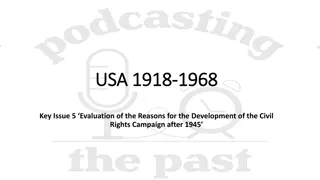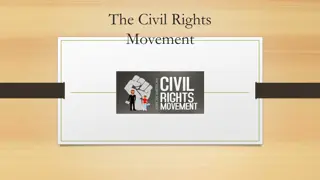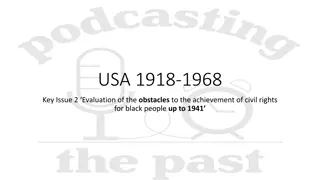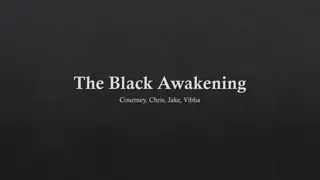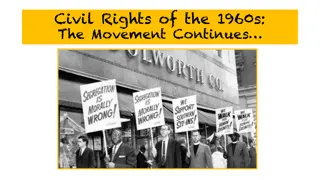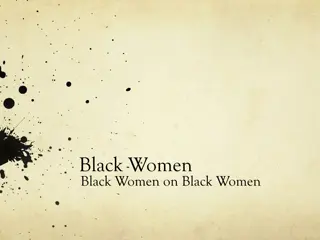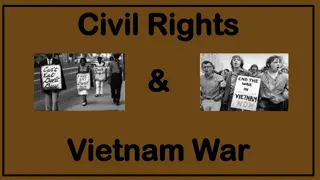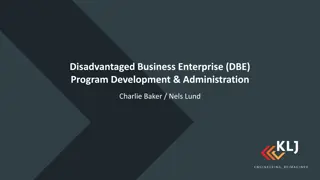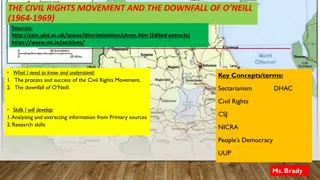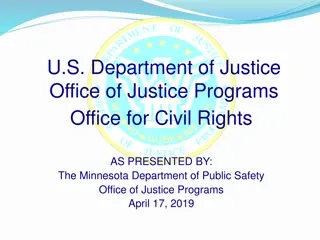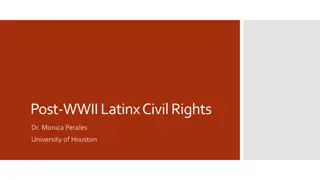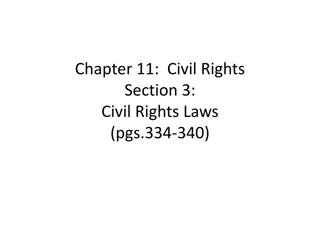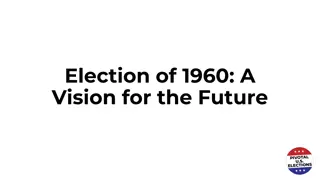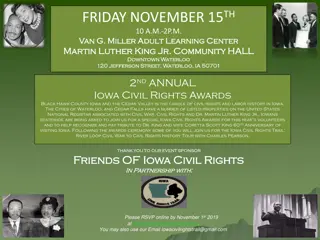The Effectiveness of the Civil Rights Movement in Meeting the Needs of Black Americans up to 1968
Assessing the impact of the Civil Rights movement on Black Americans up to 1968 reveals significant progress in ending racial discrimination and segregation, securing voting rights, and advocating for social and economic equality. Despite achievements like the Civil Rights Act of 1964 and the Voting Rights Act of 1965, challenges such as persistent social and economic disparities in urban areas indicate the movement's limited success in fully meeting the needs of Black Americans.
Download Presentation

Please find below an Image/Link to download the presentation.
The content on the website is provided AS IS for your information and personal use only. It may not be sold, licensed, or shared on other websites without obtaining consent from the author. Download presentation by click this link. If you encounter any issues during the download, it is possible that the publisher has removed the file from their server.
E N D
Presentation Transcript
USA 1918-1968 Key Issue 6 Assess the effectiveness of the Civil Rights Key Issue 6 Assess the effectiveness of the Civil Rights movement in meeting the needs of Black Americans, up to movement in meeting the needs of Black Americans, up to 1968 1968
Factors 1. NAACP 2. CORE 3. Role of SCLC and MLK 4. Social, Economic, and Political Changes 5. Rise of Black Radical Movements
Context Aims of the Civil Rights campaign: - End racial discrimination and segregation - Gain equal constitutional voting rights Following the end of WW2, this extended to include: - Better social and economic opportunities - Fairer employment opportunities Key feature of the movement, following leadership of MLK, protests were to take the form of Civil Disobedience and non-violent protest Very little FEDERAL legislation had been passed since the end of the Civil War in 1865 Most changes had been slow and local Black Radical Movement had more radical segregationist aims
Context Civil Rights Act, 1964 ended segregation federally Voting Rights Act, 1965 removed any barriers to voting restrictions Appears as though the Civil Rights Campaign has achieved it s aims Many Blacks lived in ghettos in cities in the north and west (New York, Chicago, Los Angeles) Social and economic hardships and inequalities remained Therefore rephrase the question to explain the LIMITED success
Role of NAACP and CORE Background Oldest civil rights movements and responsible for most of the groundwork that paved the way for later successes Both advocates of non-violence and peaceful protest Focused on the achievement of equal civil rights for all Black Americans
NAACP- Knowledge (BG) Oliver Brown, father of schoolgirl Linda Brown, argued it was unfair for his daughter to travel to a Black school when there was a whites only school closer to home (K1) Brown v Education 1954 (K1) The NAACP helped Brown take his case to the Supreme Court and provided legal help and financial support to keep the case going . (K1) Provided a legal precedent for ending segregation (K1) Desegregated schools (K1) Their support led to the overturning of the Separate but Equal ruling and proved a watershed moment for civil rights
NAACP Knowledge (K2) Montgomery Bus Boycott 1955 (K2) In December 1955, Rosa Parks was arrested for refusing to give up her bus seat to a white passenger (K2) Helped to organise bus boycott, ferrying Black Americans to work, kept campaign in the media. (K2) Her actions had been a preconceived plan by the NAACP, of which Parks was a member (K2) NAACP had pointed out that 75% of passengers were Black and a boycott would severely damage bus profits (K2) The arrest of Parks gave needed publicity to launch the boycott one of the first major coordinated acts of civil disobedience (K2) Segregation was ended on Montgomery s buses in December 1956.
NAACP Analysis (A1) Their Supreme Court victory did nothing to end segregation, while white mobs and the KKK continued to attack Black and sympathetic white Americans (A1) Southern states ignored federal law and schools continued to be segregated- more work had to be done to counter this resistance
NAACP Analysis (A2) Striking down of Separate but Equal was a landmark moment and established the legal precedent to strike down many other Jim Crow Laws (A2) The boycott was extremely effective and did force desegregation their initial aim (A2) It also proved the economic power Blacks could wield (A2) Segregation was only ended on public transport, not all facilities were de segregated. Again, more work had to be done to meet the needs of African Americans and gain equality.
NAACP - Evaluation (EV1) Brown vs. Board of Education turned out to be only the first blow in a new battle in the long, long war Hugh Brogan (EV2) The Montgomery Bus Boycott marked a turning point in post-war American history. It launched the movement for racial justice as a nonviolent crusade based in the Black churches of the South Eric Foner (EV) Also very useful to the USA in its propaganda war against the USSR. The USA was trying to win allies against the USSR but was finding it difficult to explain why a significant proportion of its own people were discriminated against because of the colour of their skin
CORE Knowledge (BG) CORE had organised sit-ins during the 1940s but had not gathered the attention or the momentum that the sit-ins of the late 1950s brought to the Civil Rights Movement. A sit-in is a form of direct action that involves people occupying an area to promote their desire for political or social change. It is a non -violent way to shut down a business that, in this case, was still enforcing segregation. Even though protesters were non-violent, often they were forcibly removal by the authorities which involved violence being used against them, therefore bringing publicity and sympathy to their cause. (K1) In February 1960 in Greensboro, North Carolina, 4 Black students were refused service in a whites-only restaurant (K1) They refused to leave and the next day returned with more protesters 80 in total (K1) This idea spread and by the end of 1960, 70,000 people had taken part (K1) Many white people verbally and physically attacked the protestors (K1) However, this served to publicise the campaign and was picked up by newspapers and TV
CORE- Knowledge (BG) In May 1961 CORE activists began a form of protest called freedom rides . Many states were not obeying the order to desegregate bus services after the Montgomery ruling. The freedom riders deliberately rode on buses in the city of Birmingham, Alabama, to highlight this. (K2) In 1961, CORE members wanted to highlight the segregation still prevalent in Southern states (K2) They organised Freedom Rides from Washington to New Orleans using whites only facilities to further their point (K2) They were met with protests and violence from white southerners and the KKK (K2) In Birmingham, Alabama, a bus was burned and the passengers beaten (K2) Two hundred freedom riders were arrested and spent 40 days in jail. (K2) The Governor of Alabama, John Patterson, did little to protect the riders until he was put under pressure from the new US President, John F Kennedy, to protect them.
CORE- Knowledge (BG) During the Freedom Summer of 1964, civil rights activists were focused on obtaining equal voter rights. However, at the same time, they wanted to encourage engagement with politics in the younger generations and to counter the sharecropper education received by so many African Americans. (K3) Despite Brown v. Topeka, Mississippi was still spending four times as much on educating whites as they were on Blacks. (K3) It was understood that lesser education would perpetuate economic inequality so this aimed to fix this. (K3) 41 schools were established, and attendance was voluntary. (K3) They were held in parks, kitchens, residential homes, under trees, and mostly in churches.
CORE Analysis (A1) Achieved desegregation in many restaurants and lunch counters (A1) Awareness was raised of the race issue and the Sit Ins gave Blacks strategies and inspiration to keep protesting (A1/2) Young Blacks and civil rights campaigners believed they could make a difference (A1/2) The Freedom Rides and the Sit-Ins demonstrated that anyone who opposed segregation could take direct action themselves to bring about the end of discrimination. (A2) JFK replaced Eisenhower and forced interstate bus services to desegregate (A2) Extended to include all airports, rail and bus stations (A3) 40 schools educated over 2,500 students mostly younger children, but many adults also attended.
CORE Analysis (A1) Martin Luther King s leadership and his non-violent strategy was now being openly questioned as the Supreme Court s decisions were still being ignored by many southern states, the KKK was still lynching Black people and the federal government was still not supportive of the Civil Rights Movement. (A1/2)Black protestors were being arrested, losing wages and even their jobs for what appeared to be nothing. (A1/2) Segregation continued in other areas and the protests would not solve the race issue as a whole. (A2) However, there is also a view that the Freedom Rides did very little to change the real problem experienced by Black Americans: that they had to rely on white politicians to make changes for them as they had no power to change things themselves. (A2) Many Blacks and sympathetic whites became the target for increased instances of violence in the south (A2) Black Americans and their white supporters had shown that they were no longer prepared to be intimidated. (A3) Failed to make any substantial changes to the US Constitution
CORE- Evaluation (EV2) Deliberately provoking a crisis of authority, the Riders challenged Federal officials to enforce the law and uphold the constitutional right to travel without being subjected to degrading and humiliation racial restrictions invoking the philosophy of nonviolent direct action they willingly put their bodies on the line for the course of racial justice Raymond Arsenault
Role of SCLC and MLK Knowledge (K1) MLK had emerged as an effective and talented speaker during the Montgomery Bus Boycott (K1) He was instrumental in founding the SCLC and served as one of its driving influences (K1) The SCLC adhered to King s philosophy of non-violent, peaceful protest (K1) King and the SCLC arranged to protest in Birmingham, Alabama in 1963 one of the most violent, anti-desegregationist towns in the south (K1) If they could achieve desegregation in the heart of the racist south, it would encourage the rest of the southern states to follow suit
Role of SCLC and MLK Knowledge (K2) The police chief, Bull Connor, used water cannons and dogs to attack the peaceful protestors, who included women and children (K2) Protestors did not retaliate and white Americans were outraged as they watched the violence unfold on TV (K2) After the 2ndday, the police began doubting their strategy, while businessmen were worried about the negative publicity being attracted (K2) They agreed to desegregate public facilities and restaurants within 90 days (K3) To campaign for a federal Civil Rights Act, MLK and the SCLC organised a March on Washington (K3) On 28thAugust 1963, 250,000 protestors gathered at the Lincoln Memorial (K3) The protest was broadcast live on TV and King delivered his famous I Have A Dream speech
Role of SCLC and MLK Knowledge (K4) He and the SCLC organised a march from Selma to Montgomery to publicise the issue (K4) Once again, peaceful protestors were made with extreme violence and TV images shocked and enraged many Americans
Role of SCLC and MLK Analysis (A1) King was an incredibly effective speaker who excellently harnessed the power of TV (A1) Viewers in all parts of the country could see the extreme opposition many Blacks experienced (A1) King and the SCLC were able to breakdown complex problems and make them understandable to sympathetic audiences (A1) Generated bad publicity and forced President Kennedy to order an end to segregation in Birmingham. (A1) Paved way for Civil Rights Act of 1964, Forced Governor Wallace out of job, gained the attention of Kennedy, and forced the desegregation of Birmingham.
Role of SCLC and MLK Analysis (A1/2) Caused the U.S. international embarrassment the USSR gloated that the land of the free was denying it s Black citizens the same rights as its white. (A1/2)USSR devoted 25% of its news broadcasts to the demonstrations (A2) The work of King and the SCLC largely addressed southern issues (e.g. segregation) not present in the north (A2) Many of their protests and aims were small scale and local (A2) When King and the SCLC left, Blacks living in these areas were subject to abuse and violence they had no escape
Role of SCLC and MLK Analysis (A3/4) President Johnson showed his support for civil rights, making a speech in congress declaring his support: We shall overcome (the words of the movement) (A3/4) As a white Texan man, as well as President, this was seen as a huge show of Federal support
Role of SCLC and MLK Analysis Plus (A+) The actions of the SCLC and King directly led to the Civil and Voting Rights Act (A+) This was the largest and most important change in legislation since the end of the Civil War (A+) King argued the act, gave Negroes some part of their rightful dignity, but without the vote it was dignity without strength , and pushed to remove voter restrictions on Blacks
Changes in Federal Policy Knowledge (BG) Executive Order - In the United States, an executive order is a directive issued by the President of the United States that manages operations of the federal government and has the force of law. (K1) President Truman signed EO 9981 in 1948, desegregating the US military (K1) JFK signed EO 11063 in 1962, outlawing racial discrimination in public housing
Changes in Federal Policy Knowledge (K2) President Eisenhower sent troops to Central High School in Little Rock, Arkansas, to protect 9 Black students who had enrolled in the school (K2) After the state governor was reluctant to protect the students and enforce desegregation, Eisenhower sent in the National Guard to ensure their protection (K2) James Meredith was the first Black student to apply to the segregated University of Mississippi (K2) He did this to exercise his right to attend any public institution education had been desegregated (K2) JFK sent Federal troops to ensure his protection from racist white mobs
Changes in Federal Policy Knowledge (K3) President Johnson, following this trend, passed the Civil Rights Act, 1964, outlawing segregation and racial discrimination (K3) It also had the power to charge state governments who violated the terms (K3) This was followed by the Voting Rights Act, 1965, removing voting restrictions (K3) 250,000 Black voters were added to the voting register by the end of the year
Changes in Federal Policy Analysis (A1) The precedent sent by previous governments was important in allowing President Johnson to pass the CRA (A2) The security provided by Federal troops gave the civil rights organisations greater license to protest and march, free from violence (A3) Only with this governmental support could far reaching and long lasting change be achieved (A 1/2/3) These changes were important as they showed the Federal Government was prepared to force states to comply with civil rights (A 1/2/3) They were also more sympathetic to the cause and willing to intervene
Changes in Federal Policy Analysis Plus (A+3) However, the act failed to tackle issues surrounding housing and voting (A+3) The KKK continued to terrorise any Black person who attempted to exercise their new rights
Social, Economic and Political Changes- knowledge (K1) Economic issues, unemployment, poor housing, high rents and poverty were more important in the north (K1) These problems resulted in riots within the ghettos, most famously in Watts, Los Angeles in 1965 (K1) Other race riots broke out in many urban areas across the country (K1) King had so far failed to tackle the issue of housing 800,000 Blacks lived in just 2 Chicago ghettos (K1) King and the SCLC proposed the Chicago Plan , 1966 a non-violent plan to improve the area
Social, Economic and Political Changes- knowledge (K2) Change had been happening in the background, spurred on by the Civil and Voting rights acts (K2) Interracial marriages could now take place, while Thurgood Marshall, a Black lawyer, was elected to the Supreme Court in 1967 (K3) 58% of Black Americans still experienced segregation in school in 1968 (K3) Black unemployment was 7-12% higher than whites and Black wages remained 60% ,on average, of that of white workers
Social, Economic and Political Changes- Analysis (A1) The failure of King in the north led many Black Americans to move away from the organised Civil Rights Movement (A1) Urban poverty and de facto segregation still existed for Black Americans (A2) The new Black voters allowed more representative elections to take place and enabled further change and progress (A2) King s failure to prevent the riots that broke out suggested his methods were irrelevant and ineffective to Black Americans in the late 1960 s (A1/2/3) The Civil Rights Movement split due to disagreements over the next steps (A1/2/3) The Civil and Voting Rights Acts were worthless to northern Blacks who were not affected by the issues these acts addressed
Social, Economic and Political Changes- Analysis (A1) Urban poverty and de facto segregation still existed for Black Americans (A2) King s failure to prevent the riots that broke out suggested his methods were irrelevant and ineffective to Black Americans in the late 1960 s (A1/2/3) The Civil Rights Movement split due to disagreements over the next steps (A1/2/3) The Civil and Voting Rights Acts were worthless to northern Blacks who were not affected by the issues these acts addressed
Rise of Black Radical Movements- Knowledge (K1) In 1966, Stokely Carmichael emerged as a new leader within the SNCC (K1) He called for Black Power reject white society and take pride in their own culture and Black identity (K1) He presented a more radical alternative to King s non-violent, peaceful methods (K1) He wanted Blacks to take control of their political and economic future, rather than rely on white support to give them their rights
Rise of Black Radical Movements- Knowledge (K2) Started by Huey Newton in 1966 as a political organisation to increase Black representation (K2) The Black Panthers had attracted many young, urban Blacks by 1968. They supported the anti-white, separatist ideas of Carmichael and Malcolm X (K2) However, they earned a reputation for violence and even had gunfights with police (K2) Malcolm X did not support integration: Non-violence is another work for defenceless (K2) He publicised the increasing urban problems and rejected King s approach
Rise of Black Radical Movements- Knowledge (K2) The Black Panthers raised publicity and were involved in self-help programmes in the most vulnerable areas (K2) They became involved in self-help projects in ghettos to help Blacks out of poverty, also setting up free breakfast programmes for children and free health clinics in Black communities (K3) The Kerner Commission of 1968 reported that, despite the work of the CRM, US society was deeply divided: One white society and one Black society One rich and one poor (40% of all Black Americans live in poverty) (K3)It went on to say that poverty and the problems facing Black Americans were accepted and even caused by the white community
Rise of Black Radical Movements- Analysis (A1/2) The violent rhetoric and activities of these groups resulted in a loss of white support, increased division with the CR movement and discredited the CR campaign (A2) However, the Black Panthers only numbered 2,000 members at their peak (A2) They went in to decline due to internal tensions, deadly shootouts with police and counterintelligence activities by the FBI (A2) The rise of Black radical groups, such as the Black Panthers, occurred due to the failure of earlier civil rights groups to address urban issues (A2) Their existence shows the Civil Rights Campaign did not meet the needs of all Black Americans




